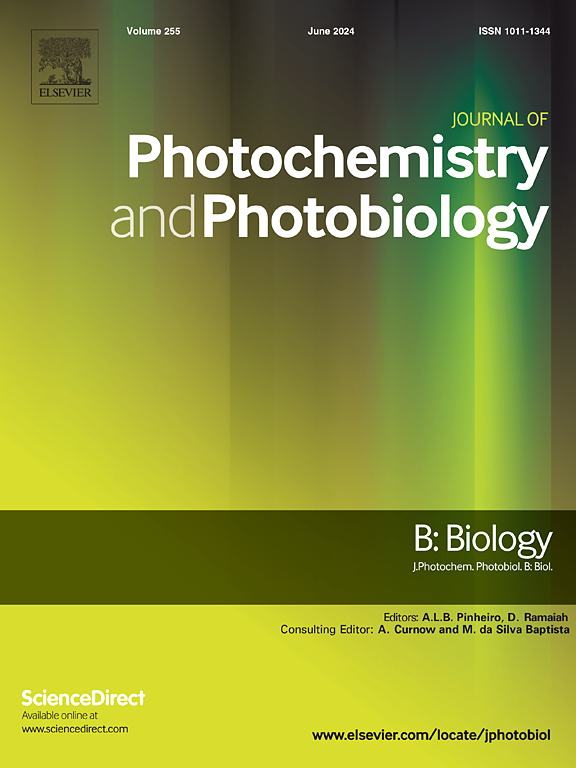用PKCδ、EGFR和JNK抑制剂预处理癌细胞可增加细胞内金丝桃素含量,增强光动力治疗的有效性
IF 3.9
2区 生物学
Q2 BIOCHEMISTRY & MOLECULAR BIOLOGY
Journal of photochemistry and photobiology. B, Biology
Pub Date : 2025-05-17
DOI:10.1016/j.jphotobiol.2025.113183
引用次数: 0
摘要
光动力疗法(PDT)是一种有效的微创治疗某些癌症的方法,它使用光敏剂(ps)在光激活时选择性地破坏肿瘤细胞。然而,乳腺癌耐药蛋白(breast cancer resistance protein, BCRP)通过各种PSs从癌细胞中主动外排,在限制PDT疗效方面起着关键作用。金丝桃素(Hypericin, HY)是一种有效的、有前景的天然PS,也是BCRP的优先底物,在BCRP过表达的细胞中,其对PDT的细胞毒性作用降低。因此,我们研究的主要目的是研究可能参与BCRP调节的信号分子调节剂(A549, HT-29, RPMI-8226和RPMI-8226/MR20)对金丝桃素介导的PDT (HY-PDT)的敏感性。我们评估了表皮生长因子受体(EGFR)抑制剂(Tyr - tyrphostin AG 1478)和C - jun n -末端激酶(JNK)抑制剂(SP - SP600125, Lico - licochalcone A)以及蛋白激酶C (PKC)激活剂(TPA)和抑制剂(Rot - rottlerin)的作用。我们的研究结果表明,所有调节剂都增强了HY-PDT的功效,但致敏程度以及特异性作用因细胞系而异。Tyr、SP和Lico预处理可显著改善rpm -8226和rpm -8226/MR20细胞的HY-PDT,而Rot预处理对A549和HT-29细胞的影响最大。更重要的是,抑制剂的增敏作用与细胞内HY积累增加有关,表明BCRP外排活性降低。虽然这些作用背后的确切机制需要进一步研究,但我们的研究结果表明,靶向BCRP和相关信号通路可以提高PDT在癌症治疗中的效果。本文章由计算机程序翻译,如有差异,请以英文原文为准。

Pretreatment of cancer cells with inhibitors of PKCδ, EGFR, and JNK increased intracellular hypericin content and enhanced the effectiveness of photodynamic therapy
Photodynamic therapy (PDT) is an effective, minimally invasive treatment for certain cancers that uses photosensitizers (PSs) to selectively destroy tumor cells upon light activation. However, the breast cancer resistance protein (BCRP) plays a critical role in limiting PDT efficacy through active efflux of various PSs from the cancer cells. Hypericin (HY), a potent and promising natural PS, is also a preferential BCRP substrate, and its cytotoxic effect in PDT is reduced in BCRP-overexpressing cells. Thus, the main aim of our study was to investigate the potential of the modulators of signaling molecules possibly involved in BCRP regulation to sensitize cancer cells (A549, HT-29, RPMI-8226, and RPMI-8226/MR20) to hypericin-mediated PDT (HY-PDT). We assessed the effects of inhibitors of epidermal growth factor receptor (EGFR) (Tyr – tyrphostin AG 1478) and c-Jun N-terminal kinase (JNK) (SP – SP600125, Lico – licochalcone A), as well as protein kinase C (PKC) activator (TPA) and inhibitor (Rot – rottlerin). Our results showed that all modulators enhanced HY-PDT efficacy, but the extent of sensitization, as well as the specific effects, varied depending on the cell line. Pretreatment with Tyr, SP, and Lico significantly improved HY-PDT in RPMI-8226 and RPMI-8226/MR20 cells, while Rot pretreatment had the strongest effect in A549 and HT-29 cells. More importantly, the sensitizing effects of the inhibitors were linked to increased intracellular HY accumulation, indicating reduced BCRP efflux activity. While the exact mechanisms behind these effects require further investigation, our findings suggest that targeting BCRP and associated signaling pathways could enhance PDT outcomes in cancer treatment.
求助全文
通过发布文献求助,成功后即可免费获取论文全文。
去求助
来源期刊
CiteScore
12.10
自引率
1.90%
发文量
161
审稿时长
37 days
期刊介绍:
The Journal of Photochemistry and Photobiology B: Biology provides a forum for the publication of papers relating to the various aspects of photobiology, as well as a means for communication in this multidisciplinary field.
The scope includes:
- Bioluminescence
- Chronobiology
- DNA repair
- Environmental photobiology
- Nanotechnology in photobiology
- Photocarcinogenesis
- Photochemistry of biomolecules
- Photodynamic therapy
- Photomedicine
- Photomorphogenesis
- Photomovement
- Photoreception
- Photosensitization
- Photosynthesis
- Phototechnology
- Spectroscopy of biological systems
- UV and visible radiation effects and vision.

 求助内容:
求助内容: 应助结果提醒方式:
应助结果提醒方式:


